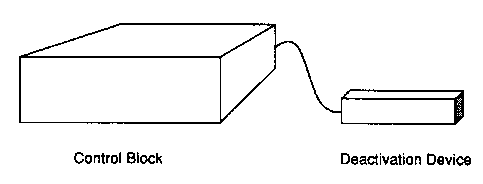Une partie des informations de ce site Web a été fournie par des sources externes. Le gouvernement du Canada n'assume aucune responsabilité concernant la précision, l'actualité ou la fiabilité des informations fournies par les sources externes. Les utilisateurs qui désirent employer cette information devraient consulter directement la source des informations. Le contenu fourni par les sources externes n'est pas assujetti aux exigences sur les langues officielles, la protection des renseignements personnels et l'accessibilité.
L'apparition de différences dans le texte et l'image des Revendications et de l'Abrégé dépend du moment auquel le document est publié. Les textes des Revendications et de l'Abrégé sont affichés :
| (12) Demande de brevet: | (11) CA 2347333 |
|---|---|
| (54) Titre français: | SYSTEME ANTIVOL A L'ETALAGE ELECTROMAGNETIQUE |
| (54) Titre anglais: | ELECTROMAGNETIC ANTI-SHOPLIFTING SYSTEM |
| Statut: | Réputée abandonnée et au-delà du délai pour le rétablissement - en attente de la réponse à l’avis de communication rejetée |
| (51) Classification internationale des brevets (CIB): |
|
|---|---|
| (72) Inventeurs : |
|
| (73) Titulaires : |
|
| (71) Demandeurs : |
|
| (74) Agent: | |
| (74) Co-agent: | |
| (45) Délivré: | |
| (22) Date de dépôt: | 2001-05-11 |
| (41) Mise à la disponibilité du public: | 2002-11-11 |
| Licence disponible: | S.O. |
| Cédé au domaine public: | S.O. |
| (25) Langue des documents déposés: | Anglais |
| Traité de coopération en matière de brevets (PCT): | Non |
|---|
| (30) Données de priorité de la demande: | S.O. |
|---|
The present invention provides an antitheft system to detect the presence of
an
object which has a label affixed thereto when said object passes through a
surveillance zone comprising an oscillatory electromagnetic interrogation
field
having three separate and distinct vector components produced by driving the
transmitting coils located in housing on either side of said surveillance zone
with
an alternating power source repetitively in and out of phase with respect to
one
another so as to form magnetic lines of flux having one vector component in
the
out-of-phase mode. The signals generated by the label are received by coils in
said housing and are processed by electronic circuitry adapted to distinguish
said
label signals from spurious signals with a high degree of accuracy. The label
can
be deactivated so as to pass through the surveillance zone without triggering
a
system response.
Note : Les revendications sont présentées dans la langue officielle dans laquelle elles ont été soumises.
Note : Les descriptions sont présentées dans la langue officielle dans laquelle elles ont été soumises.

2024-08-01 : Dans le cadre de la transition vers les Brevets de nouvelle génération (BNG), la base de données sur les brevets canadiens (BDBC) contient désormais un Historique d'événement plus détaillé, qui reproduit le Journal des événements de notre nouvelle solution interne.
Veuillez noter que les événements débutant par « Inactive : » se réfèrent à des événements qui ne sont plus utilisés dans notre nouvelle solution interne.
Pour une meilleure compréhension de l'état de la demande ou brevet qui figure sur cette page, la rubrique Mise en garde , et les descriptions de Brevet , Historique d'événement , Taxes périodiques et Historique des paiements devraient être consultées.
| Description | Date |
|---|---|
| Inactive : CIB de MCD | 2006-03-12 |
| Inactive : CIB de MCD | 2006-03-12 |
| Demande non rétablie avant l'échéance | 2004-05-11 |
| Le délai pour l'annulation est expiré | 2004-05-11 |
| Inactive : Demande ad hoc documentée | 2004-02-13 |
| Réputée abandonnée - omission de répondre à un avis sur les taxes pour le maintien en état | 2003-05-12 |
| Inactive : Page couverture publiée | 2002-11-11 |
| Demande publiée (accessible au public) | 2002-11-11 |
| Inactive : CIB en 1re position | 2001-06-26 |
| Inactive : CIB attribuée | 2001-06-26 |
| Inactive : Lettre officielle | 2001-06-19 |
| Demande reçue - nationale ordinaire | 2001-06-13 |
| Exigences de dépôt - jugé conforme | 2001-06-13 |
| Inactive : Certificat de dépôt - Sans RE (Anglais) | 2001-06-13 |
| Date d'abandonnement | Raison | Date de rétablissement |
|---|---|---|
| 2003-05-12 |
| Type de taxes | Anniversaire | Échéance | Date payée |
|---|---|---|---|
| Taxe pour le dépôt - petite | 2001-05-11 |
Les titulaires actuels et antérieures au dossier sont affichés en ordre alphabétique.
| Titulaires actuels au dossier |
|---|
| JEAN COURTOT |
| Titulaires antérieures au dossier |
|---|
| S.O. |